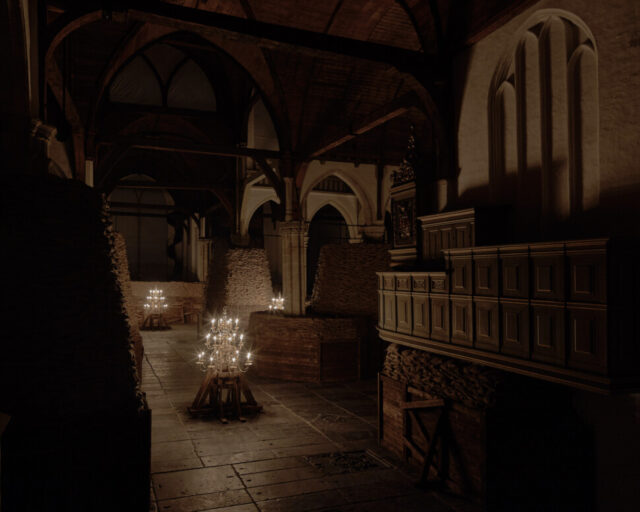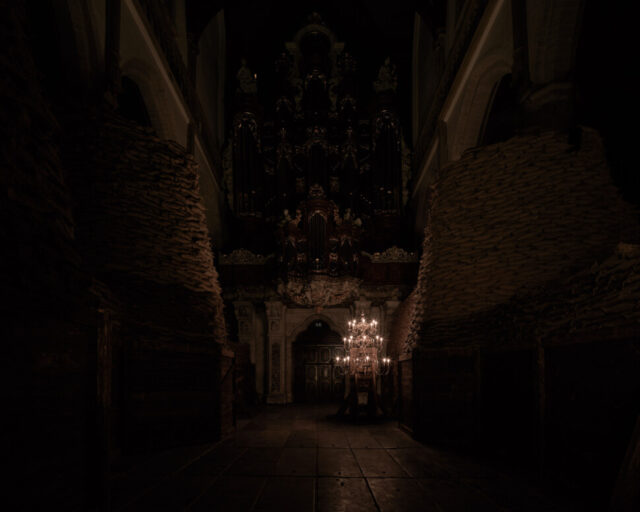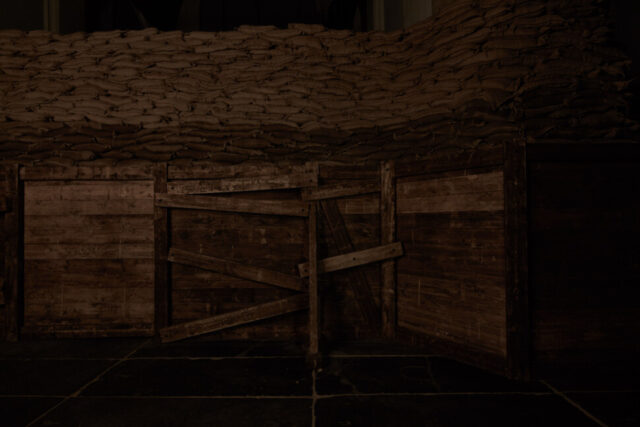Poems for Earthlings. An interview with Adrián Villar Rojas
27 December 2019
Years ago, Judith de Bruijn and I were in contact with Adrián Villar Rojas to discuss the possibility of organizing an exhibition. At the same time, Oude Kerk got interested in his work. We commonly approached Villar Rojas in 2014. Oude Kerk continued the conversation with the artist, which resulted in a spectacular exhibition. Reason enough to ask the artist a few questions.

Poems for Earthlings by Adrián Villar Rojas at Oude Kerk. Photo Jörg Baumann
JdB and MvS: You have shown your work at museums and biennials worldwide for which you mainly created site-specific work. Can you say something about your working experience at a historical and religious site like the Oude Kerk?
AVR: When working at the Oude Kerk, it’s impossible not to be captured spiritually and intellectually by the traces of perhaps the two major events in the history of the church and the Netherlands; the Reform and the Second World War. The first one may be interpreted as a return to the ascetic origins of Christianity against the corruption, power and wealth of Rome, while the latter can be seen as the arrival of the Apocalypse, the end of the world as it was known up to 1939. This extraordinary metaphysical, religious and symbolic energy somehow crystallizes in this sort of sound cosmogony I’m proposing in the Oude Kerk, together with concrete metonymic references to the strategies of heritage protection deployed in Europe during WWII: the sandbags defensive walls, the total shuttering of windows and doors, etc. We are inside a dark cavern designed both to preserve memory and to trigger it in visitors, via a paradoxical archive, an intangible and infinite entity impossible to keep in a safe: sound. Of course, it is not an explicit or chronological story of the universe–not even the golden disk put in the Voyager by Carl Sagan. It’s just a humble poem for earthlings. Arriving at this point however would have been impossible without the practice of what I call ‘housekeeping’.
JdB and MvS: What do you exactly mean by that?
AVR: ‘Housekeeping’ is a key dimension of my practice. It is the adaptation, recycling and/or rethinking of the physical space where a project will take place. This concept implies that there is no limit or division between content (the ‘artwork’) and container (the exhibition space, the gallery, the museum, etc.). This progressively growing stage in my practice has given rise to what I call the political dimension of a project, consisting of a process of analysis, diagnosis and negotiation together with the curators and authorities of an institution on what are the necessary and possible changes to be done in the physical/symbolic institutional space to ‘house’ the project. ‘Housekeeping’ goes from cleansing, painting and shifting furniture to a total restructuring of the architecture, removing or adding entire areas, staircases, electrical systems etc. It is absolutely essential to understand that ‘housekeeping’ is perhaps the most important stage or dimension in my practice, as it draws the horizon of a project, how far it will get to fulfill the organic task of fusing with its context and environment. In the Oude Kerk, this task of housekeeping has been totally accomplished.
JdB and MvS: The title ‘Poems for Earthlings’ traces back to 2011, to the Tuileries in Paris. What does this title mean to you and (how) do these two projects relate?
AVR: Almost since the beginning of my practice as a university student I realized that contemporary art could not last forever and, at the same time, that it was impossible to go ontologically beyond Duchamp, beyond the universe he had founded with the cornerstone operation of creating a readymade. What to do to escape from the doom of delivering another work of art? What to do when everything – in ontological terms- has already been done? My early answer was: to go to the shores of art, to sit down right there, as close as possible to the outer edge of the borderline, and to begin to mourn it, to mourn art and even language itself, and the entire world, and why not the entire universe, as an alien coming from another point of the multiverse with no idea of who we were, what was important for us and what kind of things and thoughts we did and had, but with only one intuitive impulse: to write a poem with all that stuff. A poem for earthlings, with mourning as the only ruling emotion. Beyond this long-term explanation, what is a better place for that title than a church? Isn’t the idea of Christ or even of God a poem for earthlings?

Poems for Earthlings by Adrián Villar Rojas at Oude Kerk. Photo Jörg Baumann
JdB and MvS: In Poems for Earthlings the experience evoked by sound and (the absence of) light plays a central part, whereas in your former projects the emphasis seemed to be on (representative) sculptural installations. Do you see that this way? And if so can you explain where this new focus comes from?
AVR: My practice has mostly involved tangible materials to produce intangible things, from hyper objects to feelings or ideas. But I’ve never been actually interested in sculpture. I never regarded myself as a sculptor. It has only been a means – a content – to develop ontological thoughts, especially about the limits of art as a field tensioned by several logics and agencies, of which not a minor one is trade, ‘the market,’ and all its exigencies to produce docile ‘objects,’ easy to sell, to transport, to install or dismantle. I used matter to criticize and provoke all these implicit rules, to besiege them from the margins at the risk of my own disappearance: my practice will hardly survive without a strong physical trace to support it, not to mention the problem of coming from the peripheries of the planet, from a country with a weak public and private apparatus to preserve its artists’ heritage. Therefore, matter – especially clay and organics – has been a huge excuse to toy with limits, and with human and non-human agencies. In this spectrum, the Oude Kerk comes as another exploration stage, where I analyze human obsession with heritage, conservation and material accumulation (gold, art, buildings, needles, whatever, but especially if it is worthy, valuable or tradable) from the intangibility and infinite abundance of sound. At the same time, I propose an introspective journey through our own personal story via this metaphorical history of sound. I always try to trigger reflection/emotion focusing the world from negativity, absence and loss, no matter what kind of matter (tangible or not) I’m dealing with.
JdB and MvS: What is the role of scale in your work?
AVR: In my practice, scale has always played the role of a measuring instrument to quantify the intensity of the host/parasite relationship I develop with a context (geographical, human, institutional, etc.). Hypertrophy is usually a risk, but when happening it means that the connection with a place, its agencies, its resources and even its Zeitgeist has also reached a hypertrophied level, so to say. Therefore, rather than ‘expressing’ an aesthetic approach or a preset decision, massive scale – or any other ‘size’ – comes to be an effect of unfolding the energy, potentialities and possibilities of a linkage with the site. This begins with ‘housekeeping’ and the political dimension of a project: how deep it sinks into a local reality mostly depends on negotiation done, affection gained, and commitment built with local agents.

Poems for Earthlings by Adrián Villar Rojas at Oude Kerk. Photo Jörg Baumann
JdB and MvS: In Poems for Earthlings visitors find themselves in a ‘timeless vacuum’ that presents an ominous scenery of sandbags together with a speculative, encyclopedic (almost Borgesian) collection of sounds. While hardly anything is visible anymore of the original interior of the church, you give space to the immaterial heritage of sound, with sandbags as a plea for its conservation. How do you view the value of material versus intangible heritage?
AVR: Sapiens have always been obsessed with matter. Since the beginning of sedentarism with agriculture, human groups have set themselves to accumulate an ever-broader archive of their material culture for the next generations to inherit. The creation of museums in modernity crystallized this inherent vice. It is true that technological means to ‘accumulate’ intangible heritage wouldn’t be acceptably developed until well into the twentieth century, but this doesn’t change the essence of the problem: as Marx suggested, we believe in matter as in a fetish or an idol, perhaps because possessing tangible things that can be saved, hidden, and put aside from strangers’ hands, is rooted in our most primitive fears and instincts of self-preservation, defense and survival. However, one should add that the most extraordinary, abundant and ever evolving technology that enabled sapiens to develop social cooperation until turning them into complex societies is intangible heritage: language, the most detailed cultural genome of any human group, one of whose dimensions is sound, meaningful sound. Beyond rock ‘art,’ until the creation of writing and of efficient means to fix it on an enduring surface, oral narration was the only means for sapiens to preserve, engross and inherit their group identity.
This interview was published on the website of Metropolis M on December 26 2019.